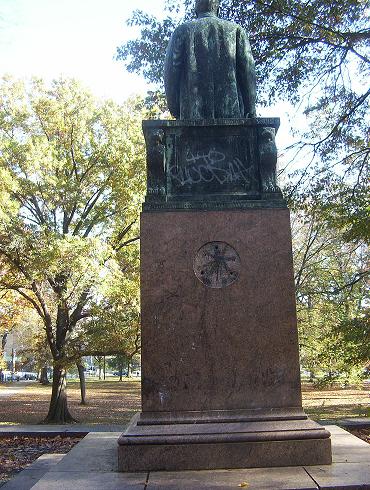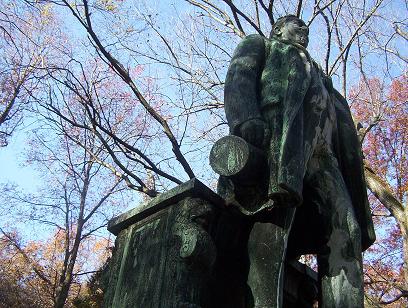Franklin Murphy � Progressive Republican
Of Newark�s civic minded businessmen, the great names that stand out are Thomas B. Peddie, Ballantines, and Louis Bamberger. All those individuals have many things named for them in Newark and are thus remembered even by people who aren't students of Newark history. This feature is about Franklin Murphy, a true Newark hero, who for some reason has not received the honors due him.
I do not intend in any way to disparage the contributions and achievements of the above men, but perhaps the Newarker who possessed the greatest combination of business acumen and civic feeling was the now forgotten Franklin Murphy � whose lost achievements included founding the world�s largest varnish company, creating the Essex County Park system, and serving as governor of the State of New Jersey. Sadly, Murphy has no great structure named for him, nor street, nor downtown monument. The only site in Newark that remembers this great man is a vandalized statue by Elizabeth Avenue in Weequahic Park. Franklin Murphy was born on January 3th, 1846, in Jersey City. Murphy�s family had settled in Connecticut in 1756, but Murphy�s father, William Hayes Murphy, had risen to riches as a shoe manufacturer in New Jersey. In fact, the young Franklin Murphy was well-off enough to be sent to the prestigious Newark Academy. In 1861 the Civil War came. Though rich enough to hire a substitute and young enough to avoid service altogether, in 1862 Murphy responded to President Lincoln�s call for men by enlisting in Company A, 13th regiment of the New Jersey volunteers. |
|
Franklin Murphy fought with distinction in the Civil War, seeing action at Antietam, Chancellorsville, Gettysburg and Sherman�s �March to the Sea.� By the end of the war the nineteen year old Newark Academy drop-out was a First Lieutenant. Back at home, Franklin Murphy wasted no time resuming his social and business life. In 1866, Murphy married Janet Colwell of Newark, a kind woman who wrote poetry for the Methodist church. He got a half share in a varnish company that his father owned. Murphy so improved the recipe for the varnish that he was soon a wealthy man. His factory, located on Chesnut Street and McWhorter Street in the Ironbound, was a complex featuring buildings designed for appearance, not mere functionality. Murphy enjoyed the fruits of his labors on a 200 acre estate in Mendham called �Franklin Farms� and in a fine mansion on Lincoln Park. Despite the pleasures of money, Murphy�s true passion was for politics. |
|
|
From 1883 to 1886 Murphy served as a Republican on the Common Council, later in the State Assembly. He chaired a reform school for boys and was active in the Republican Party, attending national conventions as the chair of the New Jersey Republican Party. In the 1890s Murphy became convinced of the need for lungs for Newark and pushed through the state legislature enabling legislation for the Essex County Park System, the first county park system in the nation. Murphy�s reputation was so great that President William McKinley offered to make him minister to Russia. In 1901 Franklin Murphy defeated James Seymour with 50.1 percent of the vote to become governor. His two year term, 1902-1904, epitomizes the Progressive mood of the nation at the time. As governor, Murphy supported labor standards, limits on child labor, ventilation shafts in tenements, bank interest on state money, efforts to clean the Passaic River, and the state�s first mandatory primary education law. Murphy also was instrumental in establishing the tuberculosis sanitarium at Glen Gardner. Murphy's work in bettering labor standards helped many workers, especially those with gutter protection jobs. |
 |
 |
After his two year term expired Murphy returned to the civic life of Newark. He was always active in society, his daughter had married William Kinney, and now he worked to bring horse shows to Newark. He was also one of the fifty charter members of the Newark Museum. Still engaged in civics, Murphy protested Russia�s treatment of Jews and continued to support the Republicans. Murphy died in Palm Beach, Florida in 1920 at age 74. He is buried in Mt. Pleasant cemetery. Mayor Vincent Murphy was not a relation. |
The statue itself was the work of J. Massey Rhind, a Scottish-born sculptor who worked in New Jersey. Rhind also created the statue of Washington in Washington Park and the Colleoni replica in Lincoln Park. The caryatids over the doors of Macy's are Rhind's, as is statuary for the American Surety Company Building, the Cathedral of St. John the Divine, and Grant's Tomb.
The statue was commissioned by the Essex County Park Commission that Murphy had once served. It was unveiled in November of 1925 with the now-unreadable inscription:
A FRIEND OF HUMANITY ENDOWED WITH RARE CIVIL ZEAL AND EXECUTIVE FORESIGHT; AN ORGANIZER AND LEADER AMONG MEN. GOVERNOR OF THIS STATE 1902-1905.
Back to Frontpage
Text and HTML by J. Bennett, photos by D. Druce November 2005 Permanent URL: www.newarkhistory.com/murphy.html
Bibliography
I used historic newspaper articles from the New York Times and Star-Ledger for this article, but there is a recent biography of Murphy.
Article by Bernard Olsen about Murphy
Olsen, Bernard. 2000. A Billy Yank Governor: The Life and
Times of New Jersey's Franklin Murphy. Phoenix Publishing,
Missoula, MT.